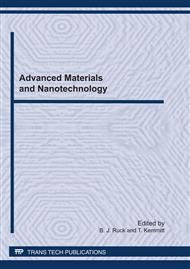p.108
p.112
p.116
p.120
p.125
p.129
p.133
p.137
p.141
Tensile and Compressive Behaviours of a Boron Nitride Nanotube: Temperature Effects
Abstract:
Temperature effects on tensile and compressive behaviours of an (8,8) boron nitride nanotube (BNNT) were investigated via the molecular dynamics (MD) simulations with the Tersoff potential parameters determined by fitting the MD simulations results to those obtained from the density functional theory calculations. The force-matching method was employed in the fitting process. It was noticed that the failure strain of the BNNT decreases from 33.9% at temperature of 50 K to 26.7% at temperature of 300 K and the critical buckling strain degrades from 5.46% to 3.98%. No obvious yielding occurs before the tensile failure of the BNNTs. A chain-like tensile failure mode was observed prior to complete breaking of the BNNT. In addition, when the BNNT was loaded beyond the critical buckling strain it behaves in a symmetrical buckling mode with a flat cross section near the middle of the BNNT.
Info:
Periodical:
Pages:
125-128
Citation:
Online since:
September 2011
Authors:
Price:
Сopyright:
© 2012 Trans Tech Publications Ltd. All Rights Reserved
Share:
Citation:


